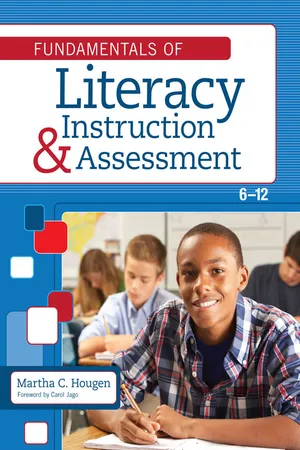
- 320 pages
- English
- ePUB (mobile friendly)
- Available on iOS & Android
Fundamentals of Literacy Instruction and Assessment, 6–12
About this book
Prepare future educators to strengthen the literacy skills of students in Grades 6–12 with this introductory reading textbook, based on the latest research, the Common Core State Standards, and recommended instructional practices. The perfect first text on adolescent literacy, this expertly organized volume covers all the fundamentals of how reading and writing skills develop in older students and how to teach literacy within key academic content areas: language arts, math, science, and history. More than 20 of today's top authorities give educators the solid, practical background knowledge they'll need for the rest of their careers, as they shape the next generation of confident readers and writers. PREPARE FUTURE EDUCATORS TO
- teach the fundamental components of literacy, with special emphasis on fluency, vocabulary, and comprehension
- address the Common Core State Standards
- prepare students for college and career by teaching literacy in content areas
- differentiate instruction for struggling students and English language learners
- implement the highly effective RTI model and other multi-tiered systems of support
- apply evidence-based instructional strategies in the classroom
- use current legislation to inform classroom instruction
STUDENT-FRIENDLY FEATURES: Practical sample lesson plans for use in tutoring and student teaching, classroom examples illustrating recommended practices, helpful chapter objectives and summaries, in-class exercises and homework assignments, an appendix of formative assessment strategies.
Frequently asked questions
- Essential is ideal for learners and professionals who enjoy exploring a wide range of subjects. Access the Essential Library with 800,000+ trusted titles and best-sellers across business, personal growth, and the humanities. Includes unlimited reading time and Standard Read Aloud voice.
- Complete: Perfect for advanced learners and researchers needing full, unrestricted access. Unlock 1.4M+ books across hundreds of subjects, including academic and specialized titles. The Complete Plan also includes advanced features like Premium Read Aloud and Research Assistant.
Please note we cannot support devices running on iOS 13 and Android 7 or earlier. Learn more about using the app.
Information
1
Teaching Literacy and Content
Objectives: After studying this chapter, you will be able to:
OVERVIEW OF THIS TEXT
Section I: Introduction to Literacy Assessment and Instruction, Grades 6–12
Chapter 1: Teaching Literacy and Content
Chapter 2: Social and Emotional Consequences of Reading Disabilities
Chapter 3: Features of Effective Instruction
Chapter 4: Academic Vocabulary Development: Meaningful, Memorable, and Morphological
Chapter 5: Fluency Development for the Older Student
Chapter 6: “Now It Makes Sense!”: Best Practices for Reading Comprehension
Chapter 7: Learning to Write and Writing to Learn
Table of contents
- Cover
- Title Page
- Copyright Page
- Dedication
- Contents
- List of Figures
- List of Tables
- About the Downloadable Material
- About the Editor
- About the Contributors
- Foreword by Carol Jago
- Preface
- Acknowledgments
- 1. Teaching Literacy and Content
- 2. Social and Emotional Consequences of Reading Disabilities
- 3. Features of Effective Instruction
- 4. Academic Vocabulary Development: Meaningful, Memorable, and Morphological
- 5. Fluency Development for the Older Student
- 6. “Now It Makes Sense!”: Best Practices for Reading Comprehension
- 7. Learning to Write and Writing to Learn
- 8. Understanding the New Demands for Text Complexity in American Secondary Schools
- 9. The What and Why of Disciplinary Literacy
- 10. Disciplinary Literacy in English Language Arts Classes
- 11. Teaching Disciplinary Literacy in History Classes
- 12. Teaching Secondary Students to Read and Write in Science
- 13. Reading and Writing as a Mathematician
- 14. Literacy in the Arts
- 15. Teaching Adolescent English Language Learners
- 16. Response to Intervention and Multi-tiered Systems for Support in Secondary Schools
- 17. Microblogging: An Example of Using Technology to Increase Engagement
- 18. Current Laws, Policies, and Initiatives
- 19. Ten Tips for Becoming an Effective Teacher
- Appendix A. Formative Assessment Strategies
- Appendix B. Helpful Web Sites
- Appendix C. Sample Lesson Plans and Instructional Tools
- Appendix D. Glossary
- Index